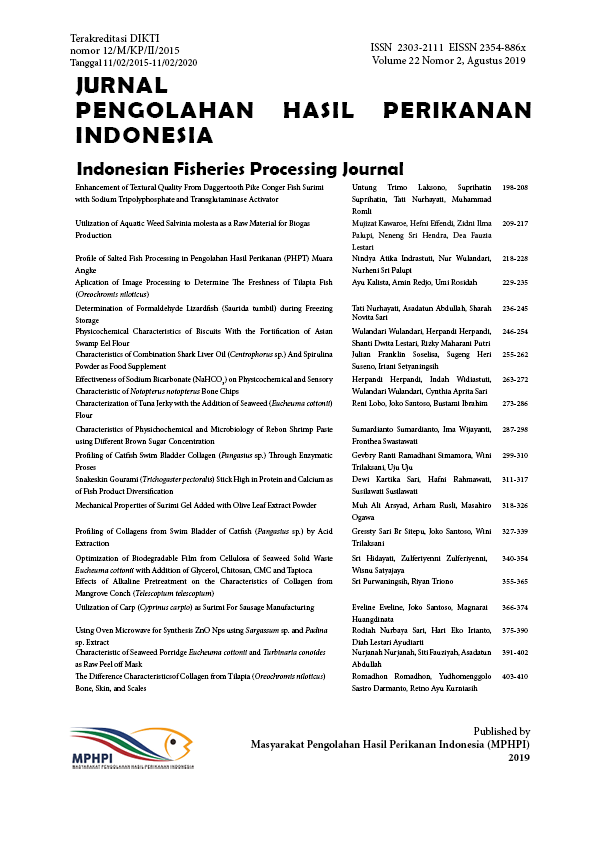Characterization of Tuna Jerky with the Addition of Seaweed (Eucheuma cottonii) Flour
Abstract
Fish jerky has hard texture which could make the appearance became less attractive to consumers. The aim of this study was to characterize tuna jerky with the addition of seaweed flour E. cottonii in order to increase acceptability by consumers. Result shown that seaweed flour characterization was consisted dietary fiber 73.95±0.45%, viscosity 107.02±0.51 cPs, gel strength 435.03±4.99 g/cm2, carageenan 54.56±0.18%, heavy metal Hg was <0.002 ppm, Pb was <0.004 ppm and Cd was 0.063±0.001 ppm, water content 12.63±0.08% and yield 6.07±0.08%. Based on research result, the additional of 2.5% E. cottonii concentration flour resulting high quality jerky with appearance value was 7.60, flavour was 7.67, texture was 5.7 and taste was 7.63 from 1-9 scales. Result from paired comparison test against commercial jerky (beef) resulting positive value, that means the quality of tuna jerky had better quality compared to commercial jerky and well accepted by panelist. Proximate analysis of tuna jerky shown that protein content 30.24±0.1%, water 11.32±0.02%, lipid 3.03±0.00% and ash 5.69±0.06%. Texture analysis results shown hardness 827.50±15.67, adhesiveness 0.09±0.02 and fracture 10.95±2.24.
Authors
LoboR., SantosoJ., & IbrahimB. (2019). Characterization of Tuna Jerky with the Addition of Seaweed (Eucheuma cottonii) Flour. Jurnal Pengolahan Hasil Perikanan Indonesia, 22(2), 273-286. https://doi.org/10.17844/jphpi.v22i2.27678

This work is licensed under a Creative Commons Attribution 4.0 International License.
Authors who publish with this journal agree to the following terms:
- Authors retain copyright and grant the journal right of first publication with the work simultaneously licensed under a Creative Commons Attribution License that allows others to share the work with an acknowledgement of the work's authorship and initial publication in this journal.
- Authors are able to enter into separate, additional contractual arrangements for the non-exclusive distribution of the journal's published version of the work (e.g., post it to an institutional repository or publish it in a book), with an acknowledgement of its initial publication in this journal.





